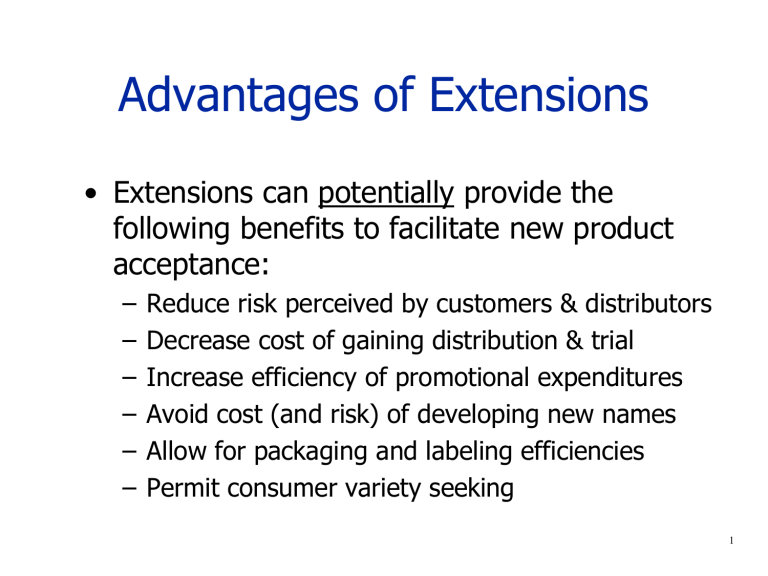Brand Extensions

Advantages of Extensions
• Extensions can potentially provide the following benefits to facilitate new product acceptance:
– Reduce risk perceived by customers & distributors
– Decrease cost of gaining distribution & trial
– Increase efficiency of promotional expenditures
– Avoid cost (and risk) of developing new names
– Allow for packaging and labeling efficiencies
– Permit consumer variety seeking
1
Advantages of Extensions
• Besides facilitating new product acceptance, extensions can also provide “feedback” benefits to the parent brand and the company as a whole
– Enhance the parent brand image
• Improve strength, favorability, and uniqueness of brand associations
• Improve perceptions of company credibility
– Convey broader brand meaning to consumers
• Clarify core benefit proposition and business definition of the company
– Bring new customers into the franchise and increase market coverage
2
Disadvantages of Extensions
• Extensions have risks, too. Certainly, they can fail.
• Moreover, extensions can potentially result in the following costs:
– Cannibalize sales of the parent brand
– Hurt the image of the parent brand
• If the extension fails
• Even if the extension is successful
– Forego the chance to develop a new brand name or market the parent brand differently
(opportunity cost)
3
Brand Extensions Assumptions
• In introducing a brand extension, it is typically assumed that:
– Consumers have some awareness of and positive associations about the brand in memory
– Some of these positive associations are evoked by the brand extension
– Negative associations are not transferred from the parent brand
– Negative associations are not created by the brand extension
4
When are Brand Extensions Appropriate?
• Brand extensions are more likely to be favorably evaluated by consumers if they see some basis of “fit” or similarity between the proposed extension and parent brand.
• It is important that the extension achieve some brand equity and contribute to the equity of the parent brand.
Therefore, the extension must also have a sufficiently high level of awareness and some strong, favorable, and unique associations.
• The major mistake in evaluating extension opportunities is failing to take all of consumers’ brand knowledge structures into account.
• Often, marketers mistakenly focus on one or so brand associations and ignore other potentially important brand associations in the process.
6
Colgate Pain killers
• Colgate started making and marketing pain killers
• Inspite of being a trusted brand when it came to mouth hygen, consumers did not buy Colgate pain killers
• There was no fit between mouth health and pain killers
7
Model of Extension Evaluations
Creating extension equity depends on 3 factors:
1. Salience of parent brand associations in extension context
2. Favorability of any inferred associations in the extension context
3. Uniqueness of any inferred associations in the extension context
9
Model of Extension Feedback
• Effects of an extension on parent brand equity depends on 4 factors:
1. How compelling the evidence is concerning the corresponding attribute or benefit association in the extension context
2. How relevant or diagnostic the extension evidence is concerning the attribute or benefit for the parent brand
3. How consistent the extension evidence is with the corresponding parent brand associations.
4. How strong existing attribute or benefit associations are held in consumer memory for the parent brand
10
Evaluating
Brand Extension Opportunities
1. A useful baseline case to study is when consumers evaluate brand extensions based on the extension itself with no other information
2. Create mental map of parent brand & identify key sources of equity.
3. Identify possible extension candidates on basis of parent brand associations and overall similarity or fit of extension to parent brand.
4. Evaluate candidate potential for a) extension equity according to the three-factor model and b) extension feedback effects according to the four-factor model.
5. Consider possible competitive advantages as perceived by consumers and possible reactions initiated by competitors.
11








